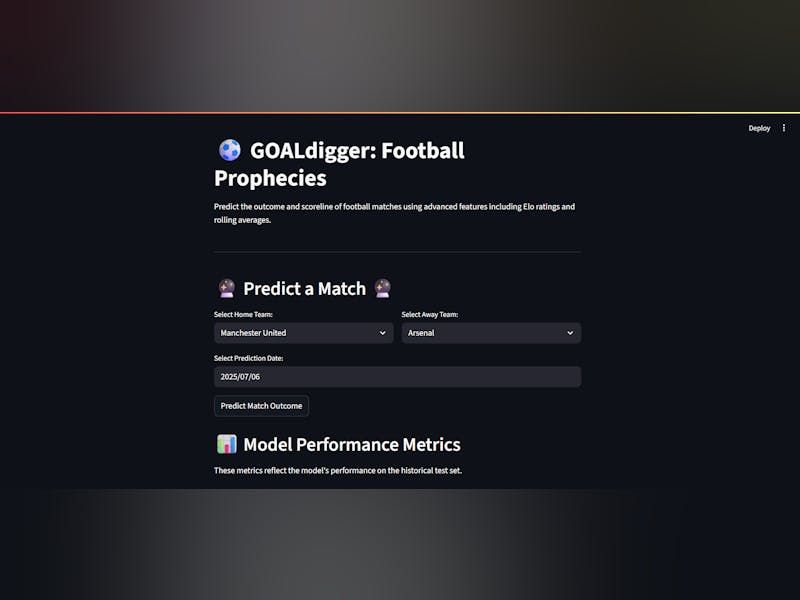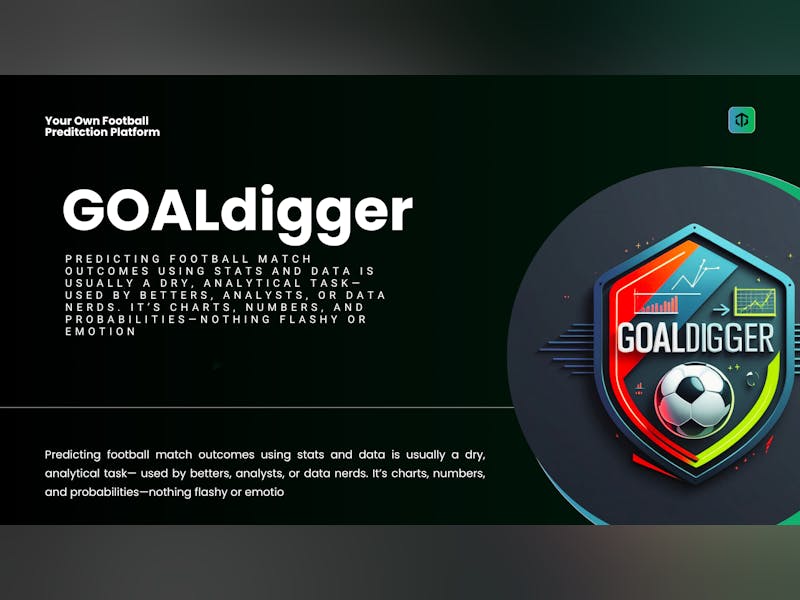GOALdigger: Football Prophecies
Unmute
Unlock the Future of Football with GOALdigger: Football Prophecies! More than just a match predictor, this is your data-powered oracle for the beautiful game. Harnessing deep learning models, historical team data, Elo ratings, and dynamic performance averages, GOALdigger delivers precise predictions for both match outcomes and scorelines. And it's not all analytics – discover its unique personality with dramatic commentary, unexpected jokes, and audio narration that transforms even the most boring draw into an epic moment. Whether you're a devoted fan, a fantasy league tactician, or simply love football with flair, GOALdigger is your ultimate tool for decoding the future of the pitch.
What tools did you use to create your project?
How much experience does your group have? Does the project use anything (art, music, starter kits) you didn't create?
We are a team of two. I led the development, machine learning, and backend integration, while my teammate Bharat handled research, design input, and content ideation—especially the creative elements like humor, user flow, and match commentary.
While we're both relatively early in our development journey, we took this project as an opportunity to push our limits, explore real-world data science workflows, and create something both functional and fun.
The entire codebase, machine learning models, and logic were built from scratch. We did not use any starter kits or templates. For audio output, we used the Google Text-to-Speech (gTTS) library, and jokes were original or curated for entertainment—but no external artwork or music assets were used.
While we're both relatively early in our development journey, we took this project as an opportunity to push our limits, explore real-world data science workflows, and create something both functional and fun.
The entire codebase, machine learning models, and logic were built from scratch. We did not use any starter kits or templates. For audio output, we used the Google Text-to-Speech (gTTS) library, and jokes were original or curated for entertainment—but no external artwork or music assets were used.
What challenges did you encounter?
One of the main challenges was integrating multiple data sources—team attributes, match histories, and Elo ratings—into a unified feature set suitable for machine learning. Ensuring temporal consistency (i.e., not leaking future data into past predictions) was crucial and tricky.
Another challenge was modeling two different tasks simultaneously: classification for predicting match results, and regression for predicting exact scorelines. Balancing their accuracy and preventing overfitting required careful tuning and experimentation.
Deploying the app with a clean UI using Streamlit was smooth, but optimizing performance (e.g., through caching and efficient feature extraction) and handling missing or incomplete data (especially in older matches) demanded robust error handling.
Finally, adding playful UX elements like text-to-speech audio, contextual jokes, and dramatic commentary meant going beyond just predictions—it became about turning stats into a compelling user experience, which was both fun and technically challenging.
Another challenge was modeling two different tasks simultaneously: classification for predicting match results, and regression for predicting exact scorelines. Balancing their accuracy and preventing overfitting required careful tuning and experimentation.
Deploying the app with a clean UI using Streamlit was smooth, but optimizing performance (e.g., through caching and efficient feature extraction) and handling missing or incomplete data (especially in older matches) demanded robust error handling.
Finally, adding playful UX elements like text-to-speech audio, contextual jokes, and dramatic commentary meant going beyond just predictions—it became about turning stats into a compelling user experience, which was both fun and technically challenging.
Made with 💖 by robots running our open-source software and GraphQL APIs.


